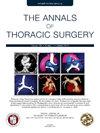Updated Postrecurrence Survival Outcomes in Patients Undergoing Pleurectomy/Decortication for Pleural Mesothelioma: A Retrospective Study
IF 3.6
2区 医学
Q1 CARDIAC & CARDIOVASCULAR SYSTEMS
引用次数: 0
Abstract
Background
Pleural mesothelioma remains a challenging disease with a high recurrence rate despite multimodality treatment. We previously described clinical outcomes associated with recurrence after pleurectomy/decortication in pleural mesothelioma. In this study, we updated these results using data from a larger, more recent cohort and identified prognostic factors influencing postrecurrence survival after pleurectomy/decortication.
Methods
We conducted a retrospective cohort study involving 251 patients who underwent neoadjuvant chemotherapy with platinum plus pemetrexed, followed by pleurectomy/decortication from January 2012 to December 2022. We calculated survival and recurrence rates using the Kaplan-Meier method and the log-rank test, respectively. Multivariable analysis with the Cox proportional hazards model was used to assess clinical factors related to postrecurrence survival.
Results
Of the 251 patients, 190 (75.7%) experienced recurrence (median follow-up, 30.9 months). The 2-year recurrence-free and overall survival rates were 37.3% (median, 21.1 months) and 72.3% (median, 44.1 months), respectively. The 1-year postrecurrence survival rate was 60.6% (median, 18.0 months). Multivariable analysis revealed that postrecurrence treatment (hazard ratio [HR], 0.12; 95% CI, 0.071-0.22; P < .0001), local recurrence (HR, 0.45; 95% CI, 0.31-0.66; P < .0001), age at recurrence <70 years (HR, 0.53; 95% CI, 0.37-0.76; P = .0007), and disease-free interval >12 months (HR, 0.43; 95% CI, 0.28-0.65; P < .0001) were independent, favorable, and significant prognostic factors of postrecurrence survival.
Conclusions
Postrecurrence treatment, recurrence pattern, age at recurrence, and disease-free interval significantly influence postrecurrence survival, indicating favorable outcomes in patients undergoing pleurectomy/decortication.
胸膜间皮瘤患者行胸膜切除术/去皮术的最新复发后生存结果:一项回顾性研究。
背景:胸膜间皮瘤仍然是一种具有挑战性的疾病,尽管采用多模式治疗,其复发率仍然很高。我们曾描述过胸膜间皮瘤胸膜切除术/去皮层术后复发的相关临床结果。在本研究中,我们旨在利用更大、更近期的队列数据更新这些结果,并确定影响胸膜切除术/去皮层术后复发生存率的预后因素:我们进行了一项回顾性队列研究,研究对象包括2012年1月至2022年12月期间接受铂类加培美曲塞新辅助化疗,随后进行胸膜切除/去皮层术的251名患者。我们分别采用卡普兰-梅耶法和对数秩检验计算了生存率和复发率。采用考克斯比例危险模型进行多变量分析,评估与复发后生存率相关的临床因素:在251名患者中,190人(75.7%)复发(中位随访时间为30.9个月)。2年无复发生存率和总生存率分别为37.3%(中位数为21.1个月)和72.3%(中位数为44.1个月)。复发后1年生存率为60.6%(中位数为18.0个月)。多变量分析显示,复发后治疗(危险比 [HR],0.12;95% 置信区间 [CI],0.071-0.22;P < 0.0001)、局部复发(HR,0.45;95% CI,0.31-0.66;P < 0.0001)、复发时年龄 < 70 岁(HR,0.53;95% CI,0.37-0.76;P = 0.0007)、无病间隔>12个月(HR,0.43;95% CI,0.28-0.65;P <0.0001)是复发后生存的独立、有利和显著的预后因素:结论:复发后的治疗、复发模式、复发时的年龄和无病间隔对复发后的生存有显著影响,表明胸膜切除术/去皮层术患者的预后良好。
本文章由计算机程序翻译,如有差异,请以英文原文为准。
求助全文
约1分钟内获得全文
求助全文
来源期刊

Annals of Thoracic Surgery
医学-呼吸系统
CiteScore
6.40
自引率
13.00%
发文量
1235
审稿时长
42 days
期刊介绍:
The mission of The Annals of Thoracic Surgery is to promote scholarship in cardiothoracic surgery patient care, clinical practice, research, education, and policy. As the official journal of two of the largest American associations in its specialty, this leading monthly enjoys outstanding editorial leadership and maintains rigorous selection standards.
The Annals of Thoracic Surgery features:
• Full-length original articles on clinical advances, current surgical methods, and controversial topics and techniques
• New Technology articles
• Case reports
• "How-to-do-it" features
• Reviews of current literature
• Supplements on symposia
• Commentary pieces and correspondence
• CME
• Online-only case reports, "how-to-do-its", and images in cardiothoracic surgery.
An authoritative, clinically oriented, comprehensive resource, The Annals of Thoracic Surgery is committed to providing a place for all thoracic surgeons to relate experiences which will help improve patient care.
 求助内容:
求助内容: 应助结果提醒方式:
应助结果提醒方式:


